Episode #12: How Inbound Marketing can Power Content that Generates Leads
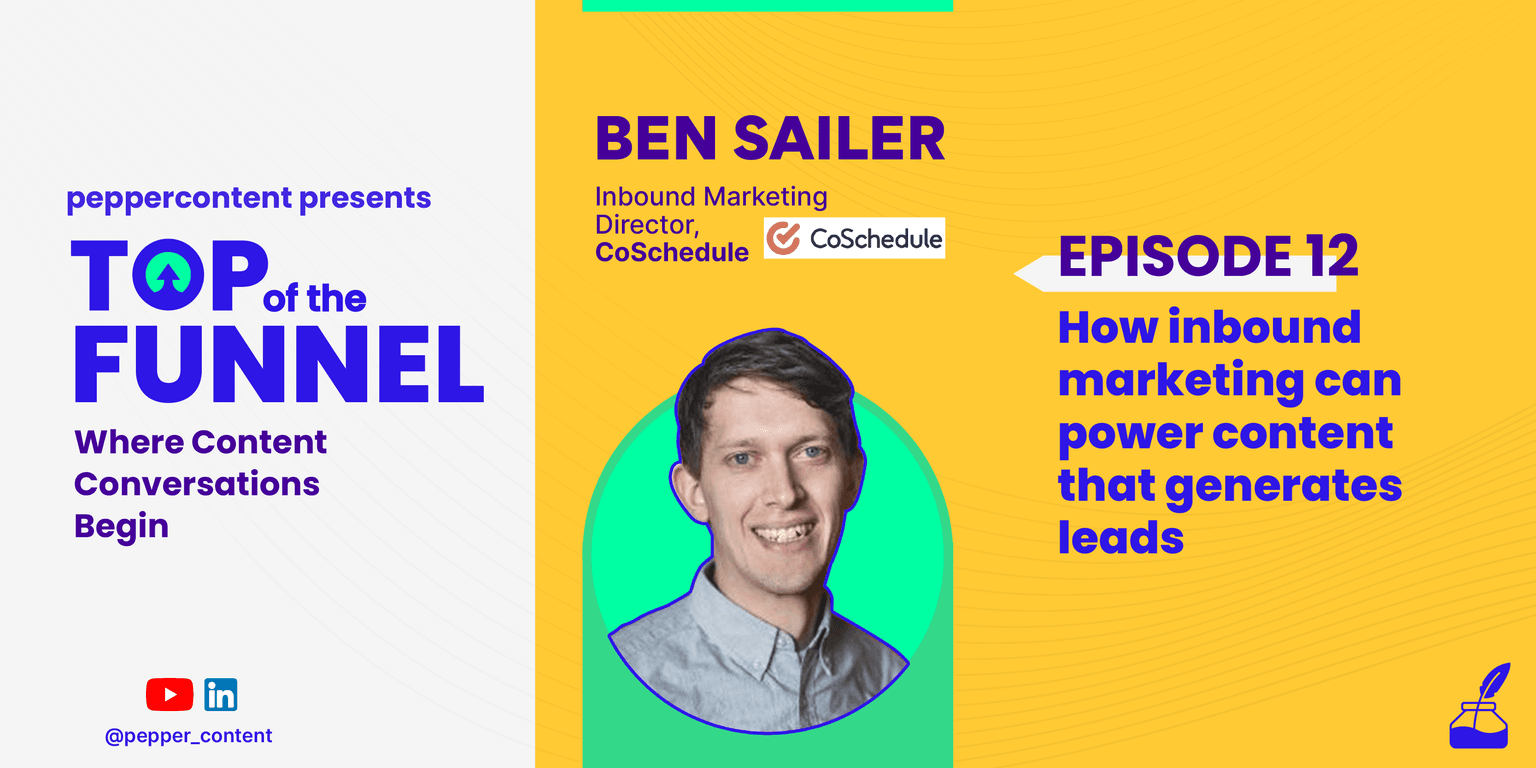
Talking ‘at’ your customers is no longer an effective practice. As the digital world is evolving, customers are well-informed and they demand transparency. Companies have to talk ‘to’ their customers and invite them into the business fold. Inbound marketing, when done properly, is an effective way of putting your organization at the forefront. It means bringing out educative and entertaining content, surrounding your niche to initiate conversations with the customers. In this way, both new and existing customers get an inside view of your company’s ideals.
Inbound marketing is a great way to improve customer relationships with the brand. Natasha Puri, Content Marketing Lead at Pepper Content, talks to Ben Sailor, the Inbound Marketing Director at Coschedule about the power of inbound marketing. He delves deeper into structuring content in a way that becomes a sustainable, lead magnet for the company.
Natasha Puri: Hello everyone. Welcome to the Top of the Funnel, the series where conversations about content begin. Our guest today is Ben Sailor, the Inbound Director at Coscehdule. This chat promises to be very informative and insightful. He has been working at Coscehdule for around six years. He also shares his writings on Linkedin and WordPress.
Let us dive right into it. Can you walk us through your role at Coschedule? What does it mean to be an Inbound Marketing specialist? What does a typical day look like for you? You could also talk about how collaboratively do you work with the content team? How is it structured?
Ben Sailor: Certainly. So, I am the Inbound Marketing Director here at Coschedule. Our inbound team is relatively small. It’s typically myself, and one or two interns on the team at a time. We have one intern right now, and we are currently looking to add another. So, inbound marketing fits right into our broader marketing team, which is divided between inbound, product marketing, marketing design, and marketing automation. It is a rather large marketing team. When we work together as a whole, it is about ten full-time members and as many interns. It is quite a large department.
A typical workday varies quite a bit, depending on what we are working on. I manage relationships with a number of freelance writers we work with and spend time formulating, interacting our content strategy, and content briefs with those writers. I spend a lot of time on SEO, brainstorming, and coming up with projects to take on, like what we should be doing. This is almost as far as I work with the content team. I am pretty much the content team, except for the interns that we work with. This is probably the most concise answer I can provide before we go into the nuts and bolts of what we do. There is certainly quite some more of that.
Natasha Puri: Let us pull back for a bit. No one knows where inbound marketing begins and content marketing ends. They are used almost interchangeably. Most people, who are content marketers are very clear that they are different. But, when you ask them, they are not very sure of the fine differences between them.
What do you think is the difference between the two? On a typical working day, how is it different in the application?
Ben Sailor: I agree that sometimes, the terms content marketing and inbound marketing get used interchangeably, even though they are different things. Many different people have a lot of different definitions for both of those things. It does not seem to me that the marketing industry has necessarily arrived at a consensus, as to what content or inbound is, or where one ends and another begins.
When I think about inbound marketing, I think about anything that is pulling an audience in a way that is non-interruptive and non-disruptive to users’ experience. It includes content marketing, creating content, and pulling an audience. Inbound can also be paper click. You can also roll email into that. Some people may think of email as content.
Nearly everything is content these days. I think of inbound as a much larger umbrella of anything that you are doing marketing-wise, that is pulling people in, rather than doing something disruptive to someone’s experience. The delineation would be like if outbound is disruptive advertising, cold calling, cold emailing prospects, inbound could be everything else.
You can even roll PR into inbound if you want to stretch the definitions like that. Content marketing, in my mind, is just one part of inbound. I think that trying to define content marketing would also be difficult.
Traditionally, many people think of content marketing essentially as written content for a website, whether it is a blog or FAQ. or some article database, or something like that. But, content marketing can also include social, email, and definitely video. I like to think of content marketing as a narrowly focused area of inbound marketing. Some of the things like PR and PPC are their own thing. This is how I like to think of content marketing. I am not sure if that is a perfect understanding. It is a worthwhile conversation certainly to know what these mean, in terms of the industry being able to plant some flags on the ground. People have a common understanding of what these terms mean.
As practitioners, as employees, who are responsible for selling these to their clients. I think it is important to know what these terms mean. But, to be completely honest, I am not sure if we are there yet in the industry. Some of these things are fairly well-defined. But, there is some fluidity there and some debate about what is and isn’t content marketing, what is and isn’t inbound, and the way we talk about these things.
As much as I think that this conversation is important, in my day-to-day work, I try not to get too bogged down in definitions or in boundaries. The way that we think about marketing, even though our marketing department is divided into different teams and disciplines, is that there are different jobs to be done and you have the skills to do it. We are not going to worry about whether that is content, whether that is inbound, or whatever label we choose to put on it. So, I guess I do not worry about it too much. But, I do like to think about it a lot.
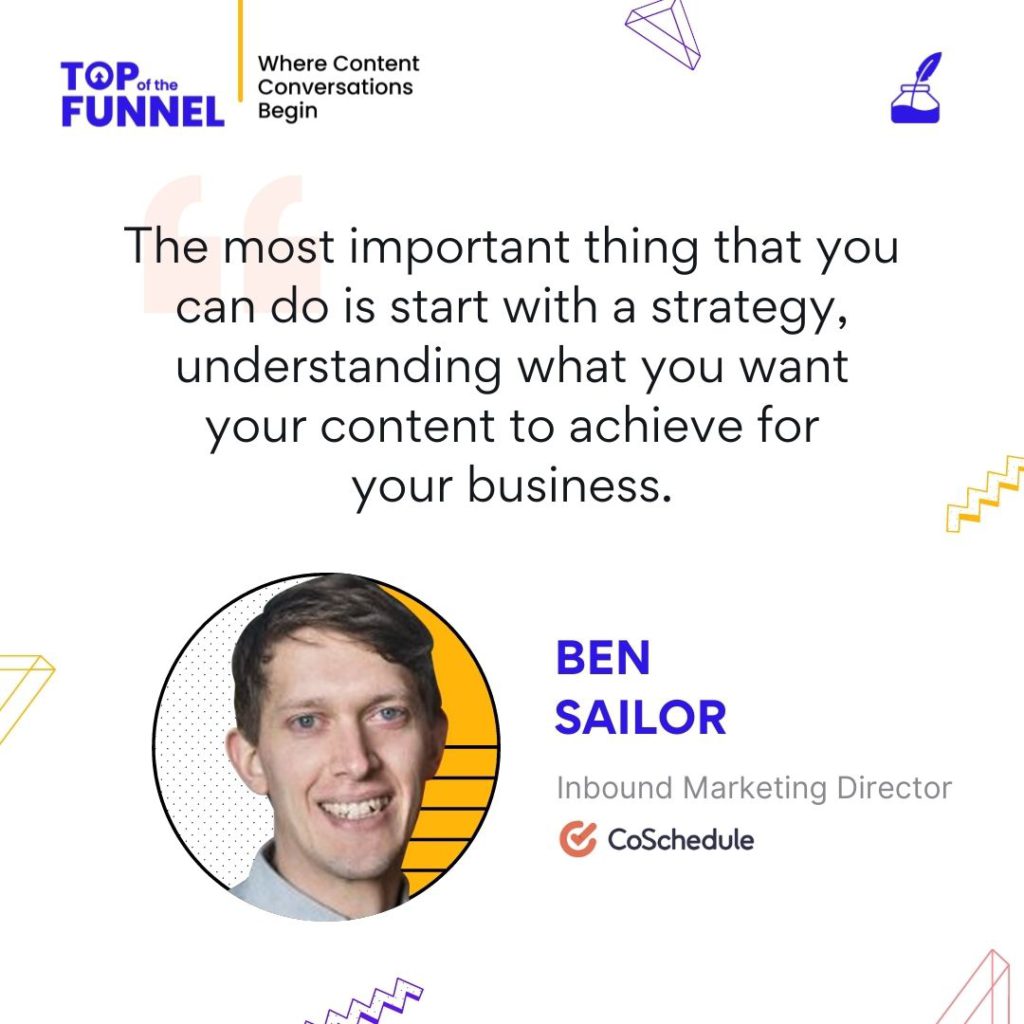
Natasha Puri: The skillset for these two roles seem to be different. Do you agree? Someone who is a really good content marketer may not be a good inbound marketer and vice versa. I think that there is an element of storytelling, some sort of comfort with content is required. Do you think that is a good distinction that one can draw?
Ben Sailor: It is a good question. Depending on how we choose to delineate content, I think that we could. Let us say take the working definitions of content for this conversation. Traditionally, we think of content marketing like blogging, video, email, social, SEO, those are typically the areas people mean when they talk about content. That set of tactics and disciplines we spoke about may need different types of skillsets. Someone good at video may not be good at SEO, and may or may not be a skilled content writer.
When we think about inbound, we are talking about inbound tactics as a whole. We think about things like paper click, PR, and all these other things that could be considered inbound. There are lots of different skillsets and disciplines. I do not think that you can necessarily hire one person, give them a generic job title, and make them do all this stuff. It would be erroneous to assume that someone who has skill as a content marketer would be a good inbound marketer.
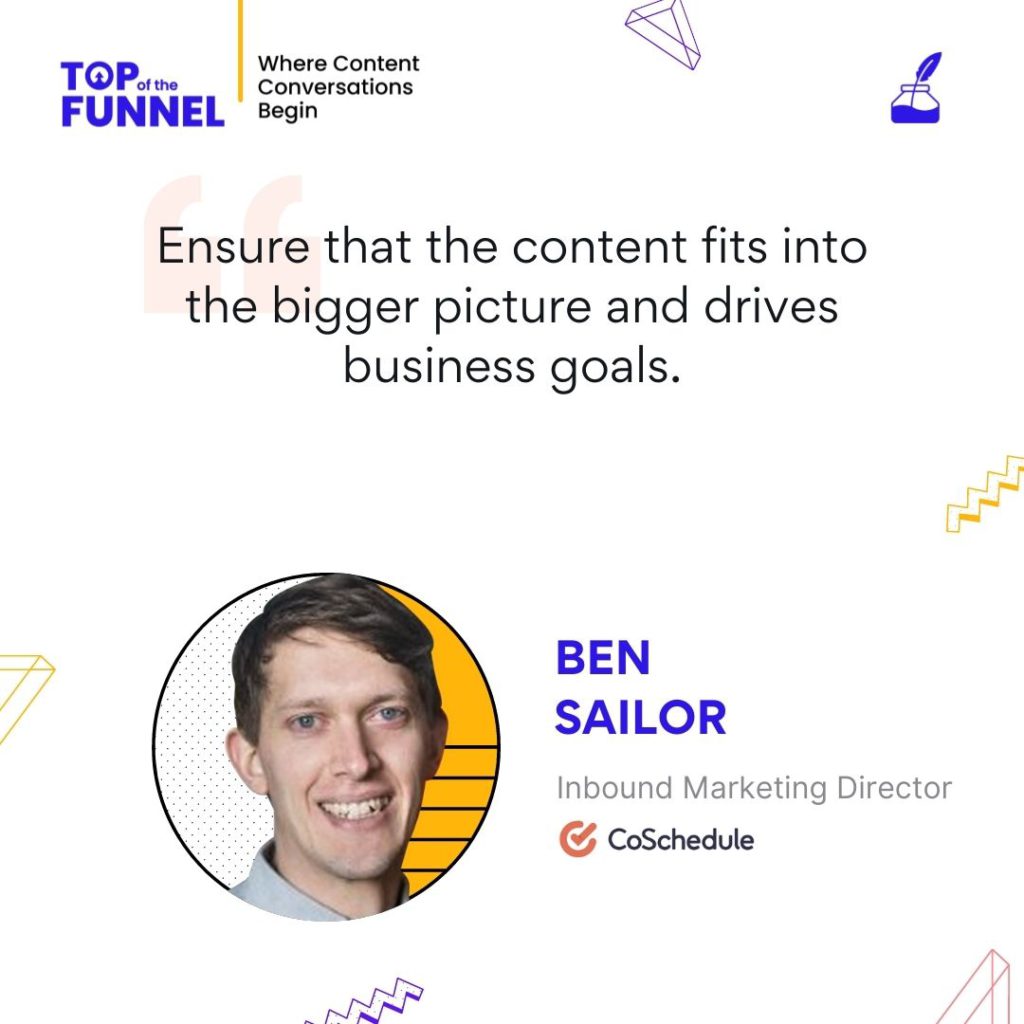
Natasha Puri: I think that they work together well. Right? It leads us to our next question. As someone experienced in inbound marketing, what are some lessons or tricks that you can share with creators, content marketers from an inbound marketing lens that they need to implement when it comes to creating a plan, or a strategy?
Ben Sailor: One of the biggest things that I would like to say is content in inbound and marketing in general, need to be tightly linked with everything in the bigger picture. Nothing exists in isolation. I think it is very common for content writers or content teams to exist in their silos and just create more and more content, without necessarily tying that content back to an overarching content strategy, or even broader marketing, or business strategy. If you have an inbound marketer as your job title, you are most probably thinking more broadly than just someone who has a content marketer, or content writer as their title.
The most important thing that you can do is start with a strategy, start with understanding what do you want your content to achieve for your business. When you think about it in that way, it kind of shifts the conversation from, ‘Let’s make good content’ to ‘Let’s make good content that grows our business.’ It is a subtle discussion, but an important one.
What happens is marketers produce good content, but when those do not produce results, they would wonder where they are going wrong. In those instances, most of the times content is not driven by an inbound strategy. So, they are creating this stuff, but they are not necessarily creating the most important content that they could to help grow their business. They are creating what they, as a creator, think is good, rather than doing what is good for the business.
I would advise them to start with a strategy. Make sure to have some idea as to where that content fits into the bigger picture and what business goals that content is intended to drive.
Natasha Puri: That is a great answer. I think it resonates with a lot of people in the field. We are creating a lot of content. Some of it is good quality content. We might think it is good enough to rank on Google. But, it is not so simple. Right? Pulling back and having that big picture view is important. It is that inbound thought process that needs to be a part of the content marketing process.
On that note, could you share some tips for optimizing the lead conversion rate from a blog? Since Coschedule has a fantastic B2B blog itself, maybe we can talk about that. How have you been optimizing the conversion rates from the blog? Is there a structure that one should be following? Is there some big-picture advice there?
Ben Sailor: I’ll do my best to answer that, starting with how we have done things for Coschedule. First of all, thank you for the kind words for our blog. I appreciate that. The way we have approached blogging as a lead generation, means, or channel, or however you call it to optimize our conversion rate is by making our content strategy very SEO-driven., as it tends to be for SaaS companies trying to drive leads. We are also not exceptional in that regard. We have applied the traditional approach of getting organic search, converting that traffic into email subscribers through very simple obtained forms, maybe like three or four fields when I ask for too much information.
We always try to provide the user with some value. All our blog posts have some research that will help the user to understand and better execute what that blog post is teaching them to do, for example like guides, templates, e-books, the things that every SaaS company does.
To answer the question of how to optimize the conversion rate, we have used tools like VWO and Hotjar. Apart from the marketing team, we also have a Web team, who take care of the development, implementation of the different tests that we run. We collaborate with them and use these tools to better understand how people navigate around the blog and how people convert.
We have been testing a lot of pop-ups lately like the ‘Hello’ bar pop-up, footer, or bottom banners, all kinds of call to action, testing the frequency, placement, color, copy, design of those CTAs. We have just tested that with some agile testing process, where we try to do as much as we can to ease, validate, or invalidate our assumptions, and just keep testing to try to get those numbers to move in the direction that we want them too. That is probably not ground-breaking.
If there is a tip that I can share, I would recommend that you test as much as you can, and as quickly as you can. Don’t worry about which ideas you like, and what you are attached to. Let the data guide your decision-making. It is probably the most important thing.
It starts with your attitude like it is very easy to start testing your form, start testing your calls to action with the mindset that you want those numbers to prove a hypothesis, or tell the story that you want them to. It is much better to detach yourself from that emotionally and just make a list of tests that you want to try and start knocking those off, one at a time, just get that data as quickly as you can. The more that you test, the more you learn. You can progress much faster, increase your lead conversion rate the way that you want to.
Natasha Puri: I think it is really important and just as easily forgotten that one can test on several levels. Let us switch over a little. Coschedule also has a podcast. I have heard amazing things about it. Why did you decide to do a podcast? Do you think that it is an important inbound lead generation tool? Can a podcast be a good way to drive traffic in the B2B space? What has been the success rate? And, how do you measure that success?
Ben Sailor: I do believe that podcasts can be an important inbound marketing tool. I cannot pull any numbers off the top of my head. Podcasts are channels that have been growing and growing in popularity for years now. Podcasts have several advantages.
One of the most important advantages that podcasts have over other mediums is something that I have heard J. Kenzo talk about. I would recommend your followers to look him up if they are interested. Something that I heard him say was that you are lucky if you get someone’s attention with a blog post for four or five minutes. With a social media post, it could be just a few seconds. If you are looking at an email, or a newsletter, you might get their attention for a bit longer. Depending on the type of email, it could be momentary as well. With podcasts, you have around 30 to 45 minutes, where you have someone’s full attention, or at least a good portion of their attention when they are doing something else.
But, in podcasts, they are actively listening to you. It is really powerful- the ability to get someone’s 30 to 45 minutes. Ideally, you have the chance to become a part of someone’s life, where they listen to you habitually. They are listening to you every day, or every two weeks, depending on whatever your cadence is. It is a remarkable opportunity.
If you are going to a podcast, you have to define for yourself what success looks like, what you want to get out of it. It is different for every brand and company. You might just want to get more subscribers, or you may want to focus on downloads, how long are people listening to each episode, and whether they are dropping off somewhere.
If you are doing podcast advertising on someone else’s podcast, or you are just showing your products or services on your podcast, you can develop means of attributing up-tech of demos and trials, or whatever you would consider to be a conversion, depending on the type of business that you run. If you are hosting podcast episodes as blog posts, you could track link clicks from the podcasts to the blog page. There are lots of ways you could measure a podcast with.
For us, we measure our podcasts’ success, or we get value from a podcast for just its ability to help us make connections with other people in the industry. It is a powerful networking tool for us. If we got nothing else out of it, it would be worth just that benefit. It is also very useful if we have questions about something.
Getting an expert on the show and racking their brains for half an hour is nothing short of consultation for us. It is very powerful and beneficial. The only other thing that I look at is downloads.
Are people listening to the show? Are downloads consistent? Ideally, we want to see the numbers go up. But, are we at least holding the attention of an engaged audience? For us, we think those three things are reasonably important to look at.
It would be fantastic if podcasts could drive sales. We are not talking about our product on the podcast. We are talking about things that might be of interest to the people, who may be interested in our product. There are so many steps that people will take in between being a podcast subscriber to buying our product that we may never be able to attribute whether that podcast had any contribution to that sale.
This may venture into a broader category. We only give one or two simple goals to any marketing tact or channel that we implement. We know that everything fits into the bigger picture, so we do not always focus on complex, high-sales. If you do the right things, you will get the right outcomes. We are comfortable with having a little bit of ambiguity around, not trying to assign a monetary value to it. As a marketer, it might be harder to answer when a COO or CEO asks us what is the value of that podcast.
You are probably not going to get too far in trying to measure it with revenue. It has a much bigger impact on growing an audience, building relationships, and just really becoming a part of people’s lives in a way that a blog post or a sales-driven email may not be able to do, that even social might not be able to do. Podcasts probably have to be measured in the depth of building a relationship with an individual.
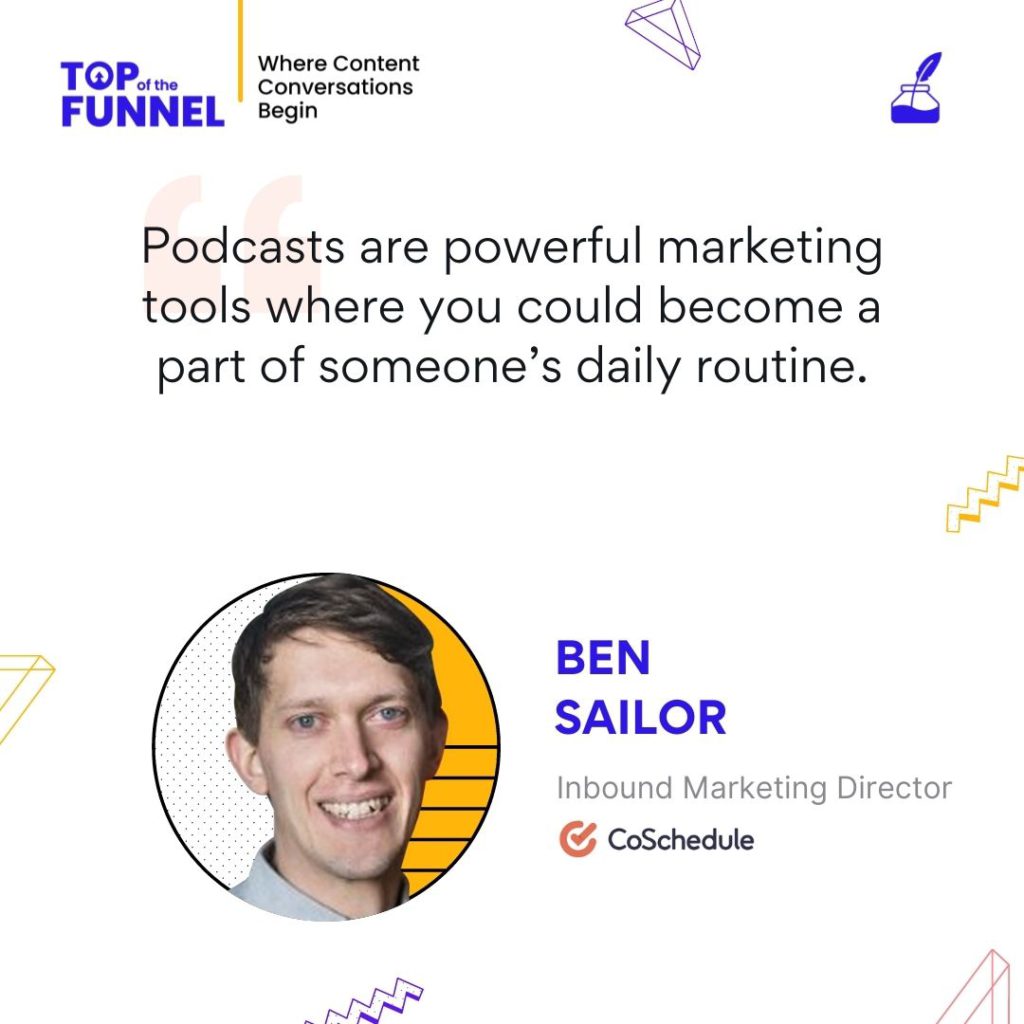
Natasha Puri: The selling point is that you are probably putting out leadership content, establishing your position as a leader. This is my 30 mins of free consulting here. This may seem repetitive around the lessons as an inbound marketer.
As an inbound marketer who has that big-picture view, you are probably frustrated with the kind of mistakes that content marketers keep on making. What are those things that you want content marketers to stop doing? What would you suggest they do instead?
Ben Sailor: It could be a long list. I want to preface everything that I say with a disclaimer that I am not judging anyone or shaming anyone in the industry. I have been a marketer for about 9 years now. I have made many mistakes. I will continue to make more mistakes. It is a part of how we learn and grow. I do not want anyone to feel bad about making mistakes. I just have a few bones to pick.
One of the common mistakes that I see content marketers make that is frustrating for me as an inbound marketer is how marketers and SEOs approach cold outreach for content promotion. The typical approach of building a format of 200 or 300 people, who have written content around your niche, and just email-blasting them, with a template that goes like, ‘Hey, I happened to find this article on the internet. Would you include this article in your…?’ It can be effective. But, it is executed in a way that can seem so transparently disingenuous that I send them straight to trash, for they are no better than spam like these people have not read out site, or gone through our content.
The process of setting up that email campaign is so automated that it does not feel human. It is easy for me to just get rid of them. However, it is frustrating to see the industry like that. For a lot of people, that is content promotion. I am not saying that aggressive emailing is bad. You need to be smarter than that.
Every once in a while, I’ll ask them the reason behind sending these emails. One of them replied saying that they would love it if I could link their most favorite article, a list of Mailchimp alternatives. It could be helpful for someone looking for alternatives to Mailchimp. But, to say that the best thing you read as a human being was a list of Mailchimp alternatives, you are either the weirdest person I have ever met, or you are lying to me. I straight up responded by asking if a list of Mailchimp alternatives is their most favorite article on the Internet and they had the audacity to respond that it is. And, at that point, I am convinced that I have engaged with this too much.
I know that it is built on lies. Every part of it is so slimy. There is an opportunity cost too, as it is time and money. You are running these campaigns when you could be doing something better, something that is more effective and won’t make you feel dirty about your work, something to make your friends proud of, instead of convincing me that a trail of Mailchimp alternatives is the best thing you read on the internet today. Nobody would believe that.
Another thing for content marketers is that they tend to lean too much into SEO. Keyword data tells you a lot. You need that data to make your decisions, but you also need to keep your business goals in mind before you do this. This is very easy to do, for I have done this. But, it does not work. You need to keep your business goals in mind like search volume, that is relevant to your business, something that you want to drive a lot of traffic on. But, if that is not connected to the business goals that you want to achieve, you can create the best content around it. It will not help.
Lastly, I think that there is a tendency to follow what experts say, rather than trusting your judgment. It leads to a lot of unproductivity at times. There is a tendency on Twitter, Linkedin, within your company, or even in a team meeting, for the loudest people to be the ones that get heard. Whatever they think becomes a kind of gospel. One popular thing that came up on Twitter is to get rid of dated content. I do not think it is a good move for every kind of business. It is okay to take strong stances. But, it is important to consider that other people may not be in the same situation, and something else may be better for them. There are lots of smart people that I follow who share advice that I know would never work for us. You do not have to argue with someone. But, you must remember their context, from where they are saying things.
Natasha Puri: You must have self-awareness about your product and where you are. One needs to be aware of where they were in the growth cycle before they take any advice.
Ben Sailor: There is something that I think about a lot. We are a subscription-based software company. To market and sell subscription-based software, we apply certain techniques. I follow many influencers, who market themselves. They do not need to drive as many leads as we need to do to build a sustainable business. They might be able to do things with 50 paying customers. We need 1000 to be able to scale. They will use a different lens to look at the world. We might suggest something that would be a terrible idea for them. They might suggest something that will not be the best use of our time. I see people just arguing about this when they do not need to. They are just in different situations, viewing the world differently. It is different for every business. Keep an open mind. You are not always doing the wrong thing. People on the internet can have contrary opinions.
Natasha Puri: My final question for you. What is the future of inbound marketing? Do you see the role of content changing? In terms of formats, maybe?
Ben Sailor: The future for us at Coschedule and the industry at large may be different. We have been successful with SEO because our company started at a good time. We have been around since 2013. When our CEO Garret started blogging, there was not much competition. Now, there is plenty. We can still compete because we have been at it for so long. We have a pretty high authority website. We can publish content and be sure that they will rank because we have so much domain authority. Emerging companies may find it harder to do. Organic social is also way harder than before. Algorithms are much less friendly than they used to be. I think we would change up our podcast a bit, work with videos, CRO, continue to get more sophisticated with email automation. We will continue to mature the things that we have been doing, as they have been working well for us.
The industry is changing so rapidly. The future of inbound, as an industry, will also look different. Companies that are getting into content and inbound now have to adopt a different approach. People are looking at building an audience as having a community means having an audience, where you are not dependent on the algorithm. Email is surging. Again, it is not dependent on algorithms and is different from SEO search volume. I think that the future of inbound is going in all directions, not being dependent on algorithms, not being dependent on a big technology platform to feed you traffic. These spaces are getting crowded. So, we might see a lot of innovation around this.
Natasha Puri: I have asked this question to almost everyone. And, most people feel that content has been powering the community. It has become the backbone of many marketing strategies.
Thank you so much. I hope that you had a good time.
Ben Sailor: I hope your audience finds it valuable.
Natasha Puri: I am sure that they will.
Latest Blogs
In this blog, explore the golden rules of using AI marketing tools so you can leverage the benefits to their maximum potential.
In this blog, you’ll learn how to avoid the pitfalls of SEO over-optimization while enhancing your site’s performance.
In this article, we’ll take a look at what AMP is, its advantages and disadvantages, and how it affects SEO.
Get your hands on the latest news!
Similar Posts
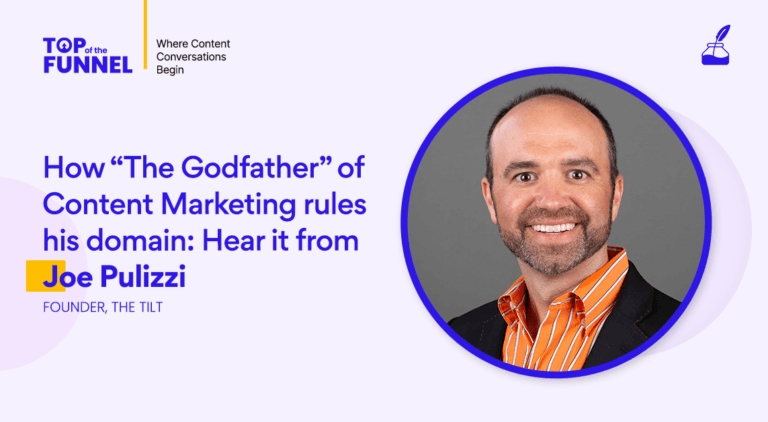
Expert Speak
18 mins read
Season 2 Episode #1 How “The Godfather” of Content Marketing Rules His Domain: Hear It From Joe Pulizzi
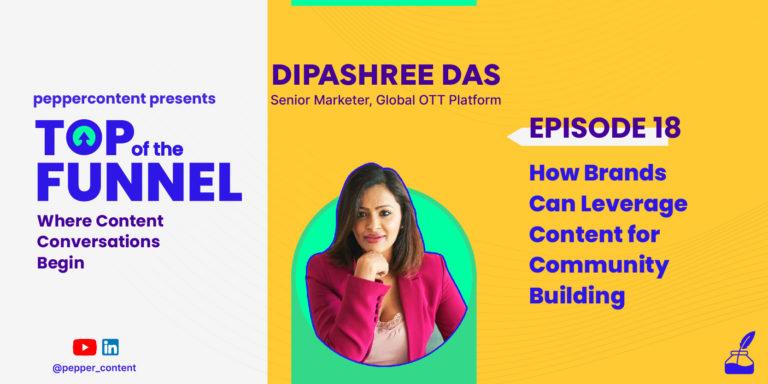
Expert Speak
16 mins read
Episode #18: How Brands Can Leverage Content for Community Building
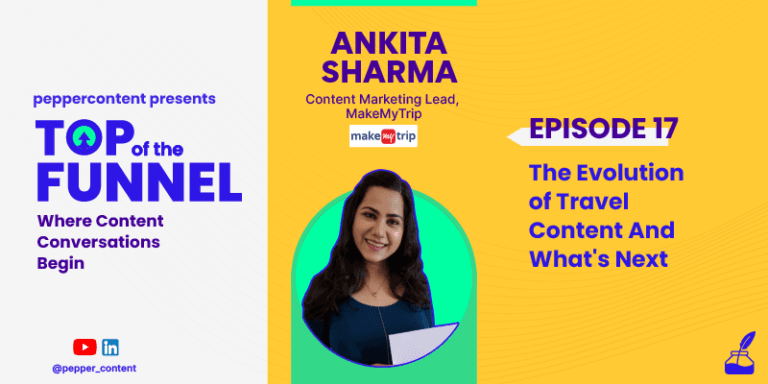
Expert Speak
11 mins read